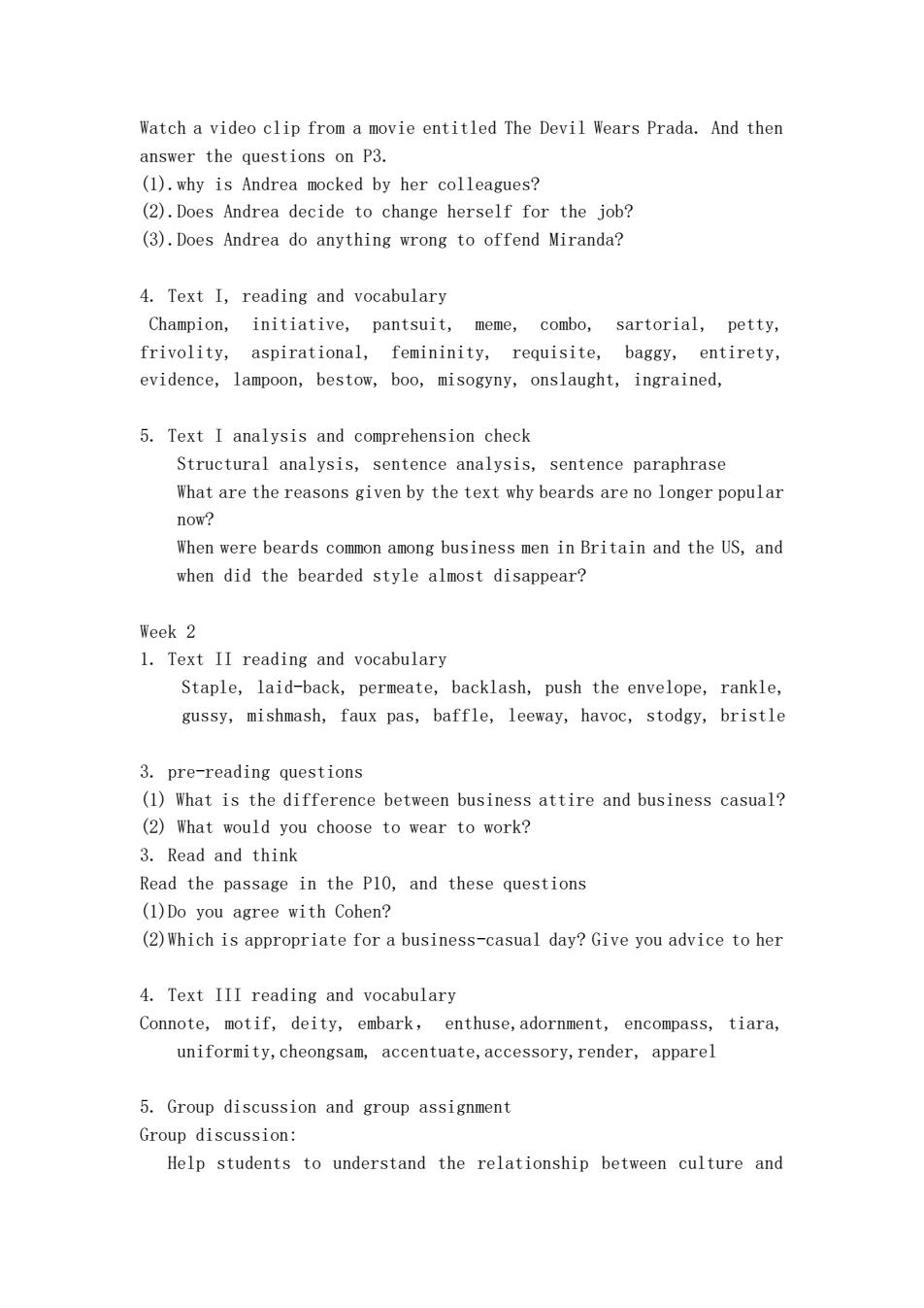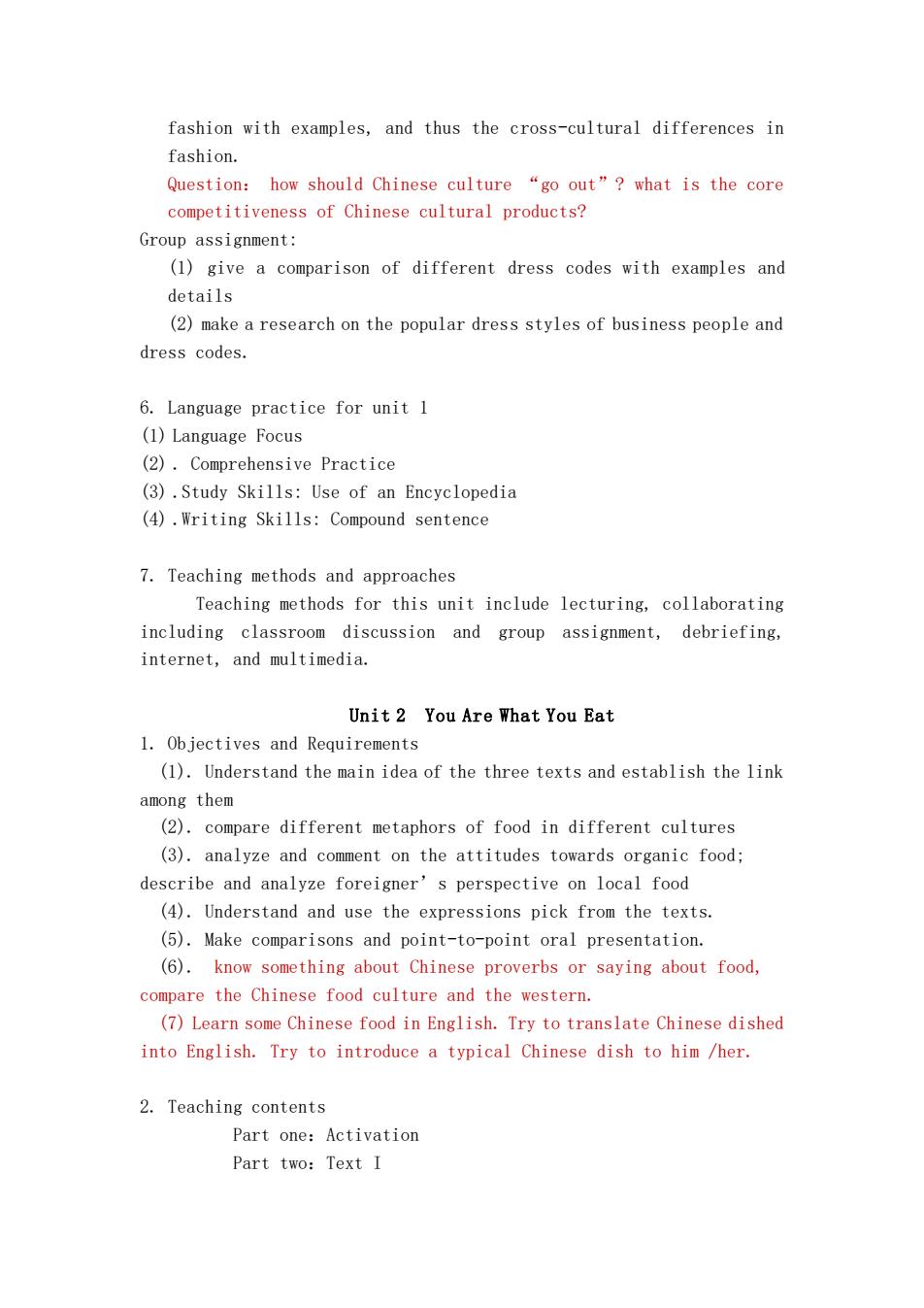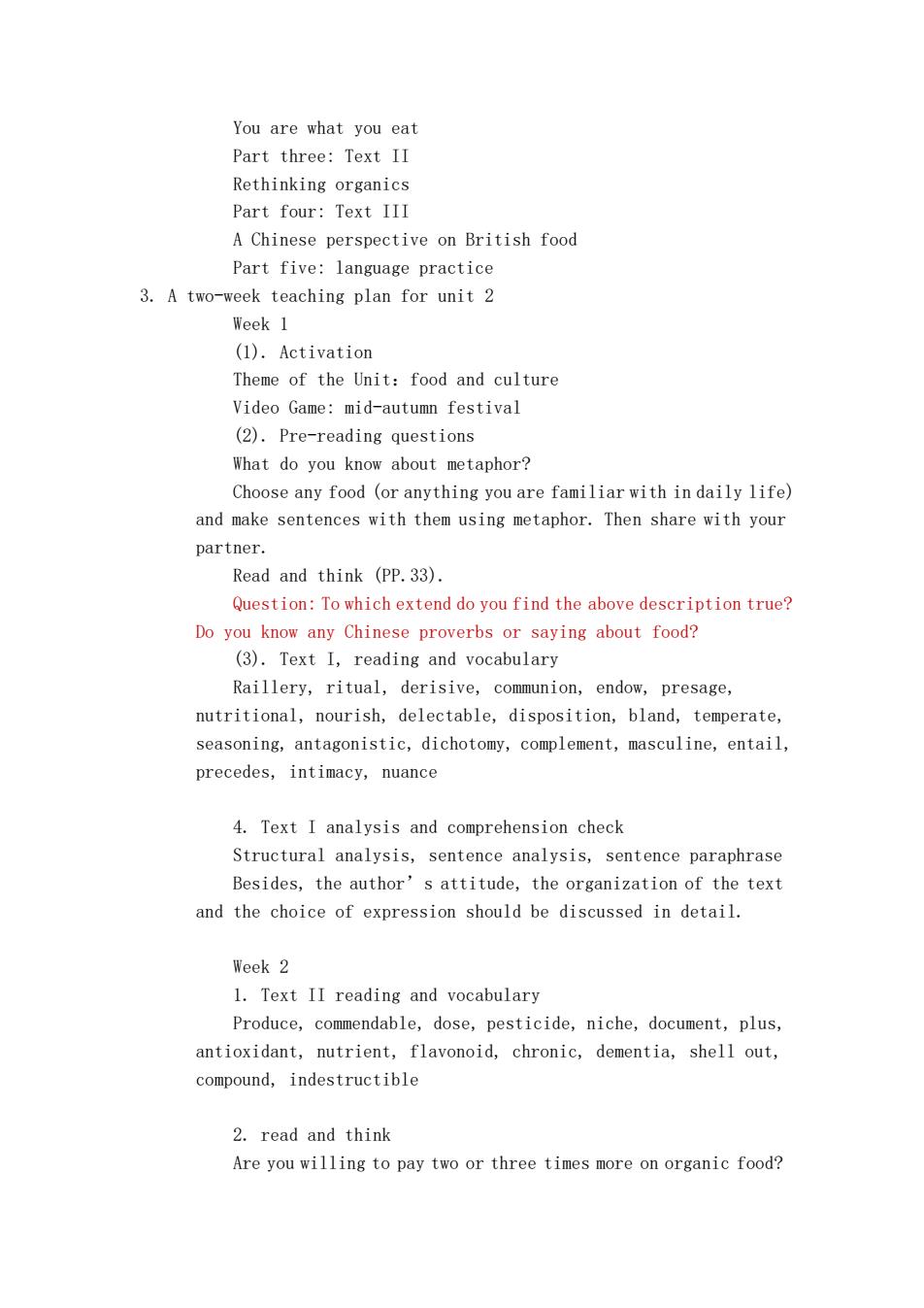
Watch a video clip from a movie entitled The Devil Wears Prada.And then answer the questions on P3. (1).why is Andrea mocked by her colleagues? (2).Does Andrea decide to change herself for the job? (3).Does Andrea do anything wrong to offend Miranda? 4.Text I,reading and vocabulary Champion,initiative,pantsuit,meme combo.sartorial.petty frivolity,aspirational,femininity,requisite,baggy,entirety, evidence,lampoon,bestow,boo,misogyny,onslaught,ingrained, 5.Text I analysis and comprehension check Structural analysis,sentence analysis,sentence paraphrase What are the reasons given by the text why beards are no longer popular now? When were beards common among business men in Britain and the US,and when did the bearded style almost disappear? Week 2 1.Text II reading and vocabulary Staple,laid-back,permeate,backlash,push the envelope,rankle, gussy,mishmash,faux pas,baffle,leeway,havoc,stodgy,bristle 3.pre-reading questions (1)What is the difference between business attire and business casual? (2)What would you choose to wear to work? 3.Read and think Read the passage in the P10,and these questions (1)Do you agree with Cohen? (2)Which is appropriate for a business-casual day?Give you advice to her 4.Text III reading and vocabulary Connote,motif,deity,embark,enthuse,adornment,encompass,tiara, uniformity,cheongsam,accentuate,accessory,render,apparel 5.Group discussion and group assignment Group discussion: Help students to understand the relationship between culture and
Watch a video clip from a movie entitled The Devil Wears Prada. And then answer the questions on P3. (1).why is Andrea mocked by her colleagues? (2).Does Andrea decide to change herself for the job? (3).Does Andrea do anything wrong to offend Miranda? 4. Text I, reading and vocabulary Champion, initiative, pantsuit, meme, combo, sartorial, petty, frivolity, aspirational, femininity, requisite, baggy, entirety, evidence, lampoon, bestow, boo, misogyny, onslaught, ingrained, 5. Text I analysis and comprehension check Structural analysis, sentence analysis, sentence paraphrase What are the reasons given by the text why beards are no longer popular now? When were beards common among business men in Britain and the US, and when did the bearded style almost disappear? Week 2 1. Text II reading and vocabulary Staple, laid-back, permeate, backlash, push the envelope, rankle, gussy, mishmash, faux pas, baffle, leeway, havoc, stodgy, bristle 3. pre-reading questions (1) What is the difference between business attire and business casual? (2) What would you choose to wear to work? 3. Read and think Read the passage in the P10, and these questions (1)Do you agree with Cohen? (2)Which is appropriate for a business-casual day? Give you advice to her 4. Text III reading and vocabulary Connote, motif, deity, embark, enthuse,adornment, encompass, tiara, uniformity,cheongsam, accentuate,accessory,render, apparel 5. Group discussion and group assignment Group discussion: Help students to understand the relationship between culture and

fashion with examples,and thus the cross-cultural differences in fashion. Question:how should Chinese culture "go out"?what is the core competitiveness of Chinese cultural products? Group assignment: (1)give a comparison of different dress codes with examples and details (2)make a research on the popular dress styles of business people and dress codes. 6.Language practice for unit 1 (1)Language Focus (2).Comprehensive Practice (3).Study Skills:Use of an Encyclopedia (4).Writing Skills:Compound sentence 7.Teaching methods and approaches Teaching methods for this unit include lecturing,collaborating including classroom discussion and group assignment,debriefing, internet,and multimedia. Unit 2 You Are What You Eat 1.Objectives and Requirements (1).Understand the main idea of the three texts and establish the link among them (2).compare different metaphors of food in different cultures (3).analyze and comment on the attitudes towards organic food; describe and analyze foreigner's perspective on local food (4).Understand and use the expressions pick from the texts. (5).Make comparisons and point-to-point oral presentation. (6).know something about Chinese proverbs or saying about food, compare the Chinese food culture and the western. (7)Learn some Chinese food in English.Try to translate Chinese dished into English.Try to introduce a typical Chinese dish to him /her. 2.Teaching contents Part one:Activation Part two:Text I
fashion with examples, and thus the cross-cultural differences in fashion. Question: how should Chinese culture “go out”? what is the core competitiveness of Chinese cultural products? Group assignment: (1) give a comparison of different dress codes with examples and details (2) make a research on the popular dress styles of business people and dress codes. 6. Language practice for unit 1 (1) Language Focus (2) . Comprehensive Practice (3) .Study Skills: Use of an Encyclopedia (4) .Writing Skills: Compound sentence 7. Teaching methods and approaches Teaching methods for this unit include lecturing, collaborating including classroom discussion and group assignment, debriefing, internet, and multimedia. Unit 2 You Are What You Eat 1. Objectives and Requirements (1). Understand the main idea of the three texts and establish the link among them (2). compare different metaphors of food in different cultures (3). analyze and comment on the attitudes towards organic food; describe and analyze foreigner’s perspective on local food (4). Understand and use the expressions pick from the texts. (5). Make comparisons and point-to-point oral presentation. (6). know something about Chinese proverbs or saying about food, compare the Chinese food culture and the western. (7) Learn some Chinese food in English. Try to translate Chinese dished into English. Try to introduce a typical Chinese dish to him /her. 2. Teaching contents Part one:Activation Part two:Text I

You are what you eat Part three:Text II Rethinking organics Part four:Text III A Chinese perspective on British food Part five:language practice 3.A two-week teaching plan for unit 2 Week I (1).Activation Theme of the Unit:food and culture Video Game:mid-autumn festival (2).Pre-reading questions What do you know about metaphor? Choose any food (or anything you are familiar with in daily life) and make sentences with them using metaphor.Then share with your partner. Read and think (PP.33). Question:To which extend do you find the above description true? Do you know any Chinese proverbs or saying about food? (3).Text I,reading and vocabulary Raillery,ritual,derisive,communion,endow,presage, nutritional,nourish,delectable,disposition,bland,temperate, seasoning,antagonistic,dichotomy,complement,masculine,entail, precedes,intimacy,nuance 4.Text I analysis and comprehension check Structural analysis,sentence analysis,sentence paraphrase Besides,the author's attitude,the organization of the text and the choice of expression should be discussed in detail. Week 2 1.Text II reading and vocabulary Produce,commendable,dose,pesticide,niche,document,plus, antioxidant,nutrient,flavonoid,chronic,dementia,shell out, compound,indestructible 2.read and think Are you willing to pay two or three times more on organic food?
You are what you eat Part three: Text II Rethinking organics Part four: Text III A Chinese perspective on British food Part five: language practice 3. A two-week teaching plan for unit 2 Week 1 (1). Activation Theme of the Unit:food and culture Video Game: mid-autumn festival (2). Pre-reading questions What do you know about metaphor? Choose any food (or anything you are familiar with in daily life) and make sentences with them using metaphor. Then share with your partner. Read and think (PP.33). Question: To which extend do you find the above description true? Do you know any Chinese proverbs or saying about food? (3). Text I, reading and vocabulary Raillery, ritual, derisive, communion, endow, presage, nutritional, nourish, delectable, disposition, bland, temperate, seasoning, antagonistic, dichotomy, complement, masculine, entail, precedes, intimacy, nuance 4. Text I analysis and comprehension check Structural analysis, sentence analysis, sentence paraphrase Besides, the author’s attitude, the organization of the text and the choice of expression should be discussed in detail. Week 2 1. Text II reading and vocabulary Produce, commendable, dose, pesticide, niche, document, plus, antioxidant, nutrient, flavonoid, chronic, dementia, shell out, compound, indestructible 2. read and think Are you willing to pay two or three times more on organic food?